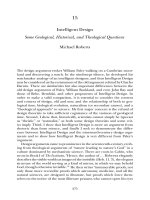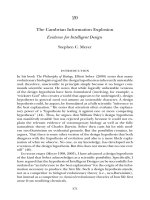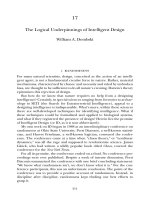Intelligent Design - Some Geological, Historical, and Theological Questions
Bạn đang xem bản rút gọn của tài liệu. Xem và tải ngay bản đầy đủ của tài liệu tại đây (114.02 KB, 19 trang )
P1: KAF-JZL
0521829496c15.xml CY335B/Dembski 0 521 82949 6 March 11, 2004 12:39
15
Intelligent Design
Some Geological, Historical, and Theological Questions
Michael Roberts
The design argument evokes William Paley walking on a Cumbrian moor-
land and discovering a watch. In the windswept silence, he developed his
watchmaker analogy of an intelligent designer, and thus Intelligent Design
may be considered as the restatement of the old argument refuted by Charles
Darwin. There are similarities but also important differences between the
old design arguments of Paley, William Buckland, and even John Ray and
those of Behe, Dembski, and other proponents of Intelligent Design. In
order to make a valid comparison, it is essential to consider the content
and context of design, old and new, and the relationship of both to geo-
logical time, biological evolution, naturalism (or secondary causes), and a
“theological approach” to science. My first major concern is the refusal of
design theorists to take sufficient cognisance of the vastness of geological
time. Second, I show that, historically, scientists cannot simply be typecast
as “theistic” or “naturalist,” as both some design theorists and some crit-
ics imply. Third, I show that Intelligent Design is more an argument from
rhetoric than from science, and finally I seek to demonstrate the differ-
ence between Intelligent Design and the nineteenth-century design argu-
ments and to show how Intelligent Design is very different from Paley’s
argument.
Design arguments came to prominence in the seventeenth-century, evolv-
ing from theological arguments of “nature leading to nature’s God” in a
culture dominated by mechanistic science. There are roots in Calvin, who
wrote in Book I of The Institutes, “Hence, the author of ...Hebrews elegantly
describes the visible worlds as images of the invisible (Heb. 11. 3), the elegant
structure of the world serving as a kind of mirror, in which we may behold
God, though otherwise invisible.”
1
He then writes “innumerable proofs, not
only those more recondite proofs which astronomy, medicine, and all the
natural sciences, are designed to illustrate, but proofs which force them-
selves on the notice of the most illiterate peasant, who cannot open his eyes
275
P1: KAF-JZL
0521829496c15.xml CY335B/Dembski 0 521 82949 6 March 11, 2004 12:39
276
Michael Roberts
without beholding them.”
2
Calvin made clear the general appeal of his ar-
gument, including both the scientific and the popular. Proof is not rational
demonstration but rather the sense of awe and beauty “demonstrating”“the
admirable wisdom of its maker.” The “recondite” side of Calvin’s “innumer-
able proofs” was taken up a century later by members of the Royal Society, as
in the Physico–theology of William Derham and other works. Robert Hooke in
Micrographia (1665) provides a fine example when he compares the perfect
design of living things to the blemishes of man’s artefacts. Brooke com-
ments, “Compared with the filigree precision of nature, human artefacts
made a very sorry sight: ‘the more we see of their shape’, Hooke observed,
‘the less appearance will there be of their beauty.’”
3
The development of the design argument in the eighteenth century cul-
minated in William Paley’s Natural Theology (1802) and William Buckland’s
Bridgewater Treatise in 1836. Paley and Buckland emphasised the perfection
of natural structures, but Hugh Miller, writing in the 1850s, focussed on
the beauty of natural structures, indicating a shift in the design argument.
4
After Darwin, the detailed appeal to design went out of vogue, though in
1884 the liberal Anglican Frederick Temple could write, “The fact is that the
doctrine of Evolution does not affect the substance of Paley’s argument at
all.”
5
Clearly, Temple’s “substance” excludes the detailed design argument
of a Paley or a Dembski. The detailed design argument has resurfaced in
recent years in both Intelligent Design and in the more general arguments
of both Old Earth and Young Earth creationists. The focus here is on Intel-
ligent Design.
the implications of geological time and the fossil
succession for intelligent design
Of most concern to a geologist is the near-absence of reference to geological
time in studies on Intelligent Design. It is as if the origin of species, whether
by direct intervention or by evolution, can be discussed without reference
to deep time, or to the succession of life. As Nancy Pearcey wrote, “For too
long, opponents of naturalistic evolution have let themselves be divided and
conquered over subsidiary issues like the age of the earth.”
6
Like Pearcey,
who is a Young Earth creationist, most intelligent designers simply ignore
issues of age as irrelevant. The issue of the succession of life through the
4.6 billion years of time clearly has an effect on how one conceives of how
life forms have come into being. If the idea of aeons of geological time is
correct – and Pearcy, Nelson, and Wise consider that idea to be wrong –
then life forms have appeared during time and have gradually changed,
either through an outside force or naturally. If the earth is only 10,000 years
old, then there is insufficient time for changes through natural means, and
thus it is reasonable to hold the abrupt appearance of species so poetically
P1: KAF-JZL
0521829496c15.xml CY335B/Dembski 0 521 82949 6 March 11, 2004 12:39
Intelligent Design
277
expressed by Milton:
The grassy clods now calved, now half appeared
The tawny lion, pawing to get free
His hinder parts, then springs as broke from bonds,
And rampant shakes his brinded mane ...
Paradise Lost, Book VII, l463-6
The Problem of Geological Time
In his Natural Theology, William Paley discussed the design of biological struc-
tures. In 1800, however, little was known of the succession of life because
the geological column had not been worked out, so Paley could not have at-
tempted to consider “creation” over geological time. By 1820, as the geolog-
ical column was elucidated, a progressive creation over millions of years was
seen as the most reasonable explanation – and one inevitable from the fossil
record – though Uniformitarians such as Lyell rejected progressivism. This
meant that instead of a few creative acts in the Six Days of Reconstitution,
7
there had been innumerable creative acts during the vastness of geological
time. Thus in the 1850s the French geologist Alcide d’Orbigny “recognised
27 successive fossil faunas in one part of the geological column (part of the
Jurassic at Arromanches in Normandy) each of which he believed became
entirely extinct as the next was created.”
8
This was used to justify his con-
cept of a geological stage, which is still accepted, though shorn of its creationist
roots. If d’Orbigny was correct and that part of the Jurassic was 10 million
years, then at the same rate of creation there would some have been some
1,500 creations since the beginning of the Cambrian.
9
This raised some difficult questions. Why did God create/design a succes-
sion of forms differing only slightly from previous forms? Why was extinction
allowed? Assuming evolution has not occurred, then the Designer returned
at regular intervals to modify a previous creation as motor manufacturers
give an annual revamp to their models. In England, such questions were
put aside for a time after the formation of the Geological Society of London
in 1807, as the most important task was stratigraphy – that is, elucidating
the historical succession of strata, rather than providing any interpretative
framework, thus avoiding the problem of design over time. From 1800 to
1850, geologists worked out the geological column from the Cambrian to
the postglacial and the fossils embedded in them, without acceptance of
evolution. This demonstrated the succession of life, which is derived from
the principle of superposition rather than based on any hypothesis on the origin
of life. Thus by 1850, the general order was the same as what we have today,
though there was a marked absence of human fossils. However, this avoided
the question of change over time, which would not go away.
P1: KAF-JZL
0521829496c15.xml CY335B/Dembski 0 521 82949 6 March 11, 2004 12:39
278
Michael Roberts
A fine early example of a study on the succession of life can be found
in John Phillips’ Treatise of Geology of 1838. He dealt with the subject again
that year for Baden Powell.
10
After giving “[t]he order of development of
life,” he wrote: “Is the present creation of life a continuation of the previous
ones; . . .? I answer, Yes; but not as the offspring is a continuation of its parent.”
His meaning is clear – there has been a succession of similar species, each
separately created and differing only slightly from its predecessor, but no
descent. Phillips thereby allowed the direct creation of each species and
thus retained the argument from design almost intact. This meant that any
possibility of evolution could be sidestepped.
The Young Darwin on a Nonevolutionary Succession of Life
Phillips was a lifelong opponent of evolution, but Darwin made a fascinat-
ing use of Phillips’s ideas, when toying with evolution in his B Notebook of
1837–38.
11
This was nine months before he read Malthus and thus predates
natural selection. Darwin agreed with Phillips’s historical ordering of fossils,
but not with his successive creations. In the B Notebook we see Darwin the
geologist arguing historically and abductively for evolution. From page 167,
he was using Phillips for historical information on fossils, “fish approaching
to reptiles at Silurian age” (B 170), and asking, “How long back have insects
been known?” (B 171) Having asked the when questions, he then asked the
why. Crucial is his earlier statement, “Absolute knowledge that species die
& others replace them,” but “two hypotheses [individual creation and com-
mon descent] fresh creation mere assumption, it explains nothing further,
points gained if any facts are connected” (B 104). Here Darwin appears to
dismiss the view of Phillips cited earlier. Later he asked, “Has the creator
since the Cambrian formations gone on creating animals with same general
structure. – miserable limited view” (B 216). And he argued, “My theory will
make me deny the creation of any new quadruped since days of Didelphus
12
in Stone[s]field” (B 219). This is in contrast to the Origin of Species, where
Darwin argues by analogy from artificial selection and then from the fossil
record and biogeography. In the B Notebook he was arguing for the in-
ference from the best explanation to explain the succession of life, but in
1859 he argued for the mechanism first and then gave a minor abductive
argument from biogeography and the fossil record. However, the original
basis of his “one, long argument” was abduction from the fossil record. In
fact, Darwin was more successful in convincing others that evolution was the
best historical interpretation of the fossil record than he was in arguing for
natural selection.
13
This is contrary to Johnson’s alleged materialist model of
evolution, where “a materialistic evolutionary process that is at least roughly
like neo-Darwinism follows as a matter of deductive logic, regardless of the
evidence.”
14
Darwin had argued abductively and inductively from the his-
torical evidence, and then by analogy. He had taken the long chronology
P1: KAF-JZL
0521829496c15.xml CY335B/Dembski 0 521 82949 6 March 11, 2004 12:39
Intelligent Design
279
of “creationist” geologists and then, and only then, argued for evolution
and the virtual absence of creative acts to explain the progression of life
forms. This was a bold step, as there were few detailed sequences such as
the elephant, the horse, and Triceratops and allied species.
Miller, in Finding Darwin’s God,
15
mischievously considers design in rela-
tion to elephants, with twenty-two species in the last six million years and
many more going back to the Eocene. If all were “formed” at about the
same time, ca. 8000 b.c., then the only reasonable explanation is some kind
of intelligent intervention, which designed each to be different, rather like
cars made by Chrysler and GM over several decades.
If the geological time scale is correct, then these different fossil elephants
appeared consecutively and, despite “gaps,” form a graded sequence. They
indicate only “annual model upgrades.” Assuming that this is a fairly com-
plete sequence, the Intelligent Designer seemed to have adopted the same
sequence of modifications as would be expected by evolution. This is exactly
the point Darwin made in his 1844 draft:
I must premise that, according to the view ordinarily received, the myriads of or-
ganisms, which have during past and present times peopled this world, have been
created by so many distinct acts of creation. . . . That all the organisms of this world
have been produced on a scheme is certain from their general affinities; and if this
scheme can be shown to be the same with that which would result from allied or-
ganic beings descending from common stocks, it becomes highly improbable that
they have been separately created by individual acts of the will of a Creator. For as
well might it be said that, although the planets move in courses conformably to the
law of gravity, yet we ought to attribute the course of each planet to the individual
act of the will of the Creator.
16
The Playing Down of Geological Time in Intelligent Design
The example from Miller highlights why the avoidance of geological time
results in problems. Behe focuses entirely on biochemistry and Dembski on
detecting design. Both accept a long time scale but do not consider the impli-
cations for their understanding of design. Thus the formation of biological
complexity is considered without any reference to the history of life and its
time scale in a way that is reminiscent of Lessing’s ditch, in that “accidental
truths of history can never become the proof of necessary truths of reason.”
17
The acci-
dental truths of geology are simply ignored for the purposes of demonstrat-
ing Intelligent Design. In the volume The Creation Hypothesis, Stephen Meyer
argued cogently for what he called The Methodological Equivalence of Design
and Descent, but swung the argument in favour of design by omitting any
reference to geological time. If geological time is accepted, then the choice
is between Phillips (design or multiple abrupt appearance) and Darwin (de-
scent), as discussed earlier. If geological time is not accepted, then design
is the only choice. Kurt Wise likewise avoided the issue of age in his essay
P1: KAF-JZL
0521829496c15.xml CY335B/Dembski 0 521 82949 6 March 11, 2004 12:39
280
Michael Roberts
“The Origins of Life’s Major Groups,” failing to see that the awareness of the
change in organisms over time came through detailed stratigraphy rather
than by interpreting them though the theories of “macroevolution, progres-
sive creation, global deluge.”
18
The early geologists tediously recorded the
order of strata without asking questions of origins, though their vast age
was common knowledge.
19
(Wise’s idea that the fossil record is explained
by rising flood waters is simply absurd. This type of approach justifies critics
such as Pennock and Eldredge in dismissing ID as a variant of Young Earth
creationism.)
Perhaps the demonstration of evolution from the fossil record falls short
of “rational compulsion,” as the geological argument for evolution is abduction
or inference of the best fit. Considering the fossil record within a four-billion-
year time scale abductively, the best fit is gradual change over time (with or
without interference). But within a short timescale of 10,000 years, the best
and only fitisabrupt appearance. To avoid citing the evidence of the fossil
record and vast time (and merely to mention, or even to parody, the Cam-
brian Explosion)
20
may be good practice for a defence lawyer, but not for a
scientist.
Unless one rejects geological time, the fossil record points either to pro-
gressive creation with regular interventions (the common pre-Darwinian
view) or to evolution, possibly with occasional “interventions.” The starting
point has to be an ancient Earth and the “absolute knowledge that species
die & others replace them.” To regard geological time as a subsidiary issue
would deny that.
design, theistic science, and naturalism: a historical
perspective from
16901690
to
19001900
Whereas Johnson, Behe, and Dembski often present the case for Intelligent
Design without reference to theology, Plantinga and Moreland stress the
need for theistic science, whereby theology almost becomes part of science.
Theistic science is open to the direct activity of God, whereby these acts are
demonstrated on theological grounds. Thus J. P. Moreland itemises “liber-
tarian, miraculous acts of God” as being “the beginning of the universe, the
direct creation of first life and the various kinds of life, the direct creation of
human beings in the Middle East, the flood of Noah,” and “for some, the ge-
ological column”
21
and the crossing of the Red Sea.
22
This has great appeal
to those who wish to stress the supernatural nature of Christian belief.
diluvial or flood geology; theistic or naturalistic?
John Ray and Edward Lhwyd
With the apparently Christian origin of science in the seventeenth century,
it is tempting to see science as moving from a theistic base to a naturalistic one
P1: KAF-JZL
0521829496c15.xml CY335B/Dembski 0 521 82949 6 March 11, 2004 12:39
Intelligent Design
281
over two centuries. This appears to be so in considering the formation of life
and also in seeing the Flood as the cause of strata. Thus the Flood may be
seen as an example of divine intervention, invoked from the seventeenth to
the early nineteenth century. Because the seventeenth-century theorists of
the Earth wrote so biblically of Creation, Flood, and Conflagration, their es-
pousal of a kind of naturalism or theory of “secondary causes” is overlooked.
S. J. Gould expounds this view, writing, “Burnet’s primary concern was to
render earth history not by miracles, but by natural physical processes.”
23
Gould described Burnet as a “rationalist”; Johnson would call him a natural-
ist. A similar willingness to explain geological features by natural processes
is found in Ray’s discussion of erratic blocks
24
in the second edition of Mis-
cellaneous Discourses Concerning the Dissolution of the World.
25
Ray was writing in
response to a letter from Edward Lhwyd, who wrote to Ray on February 30,
1691, “Upon the reading on your discourse of the rains continually washing
away and carrying down earth from the mountains, it puts me in mind [of
something that] I observed,” and then described what he had observed in
Snowdonia. He described innumerable boulders that had “fallen” into the
Llanberis and Nant Ffrancon valleys, which are two U-shaped glacial val-
leys. (Most of these rocks are erratics deposited by retreating glaciers.) As
“there are but two or three that have fallen in the memory of any man now
living, in the ordinary course of nature we shall be compelled to allow the
rest many thousands of years more than the age of the world.”
26
Lhwyd was
reluctant to ascribe them to the Deluge, and Ray commented evasively on
Lhwyd’s findings in order to avoid facing the logic of Lhwyd’s comments.
27
On the issue of geological time, Ray nailed his colours firmly to the fence,
without explicitly rejecting an Ussher chronology. His evasiveness to Lhwyd
shows that he was reluctant to posit a divine intervention at the Deluge. Ray
equivocated between a naturalistic and a supernatural explanation.
Early Nineteenth-Century Geologists
Moving on to the 1820s, let us consider the clerical geologists Henslow,
Sedgwick, Buckland, and Conybeare, who contributed so much to geology:
Henslow on Anglesey,
28
who influenced Darwin’s geology far more than
Lyell; Sedgwick, who elucidated the Cambrian and taught Darwin; Buckland
for the first Mesozoic mammal and for introducing the Ice Ages to Britain;
and Conybeare on the ichthyosaur. Cannon, in a classic article, claimed that
they were Broadchurchmen,
29
that is, proto-modernist; but Pennock por-
trayed Henslow and Sedgwick as ardent adherents of “the detailed hypothe-
ses of catastrophist flood geology,”
30
which they allegedly taught Darwin.
Thus Henslow and Sedgwick were supernaturalists. Both cannot be right.
Pennock has presented a simplistic either/or – either to be totally naturalistic,
as Darwin (possibly) became, or to misguidedly base one’s science on theol-
ogy, as did(n’t) Sedgwick and Henslow. It is a simple thesis, which misunder-
stands Sedgwick’s and Henslow’s geological method. Ironically, Pennock’s









